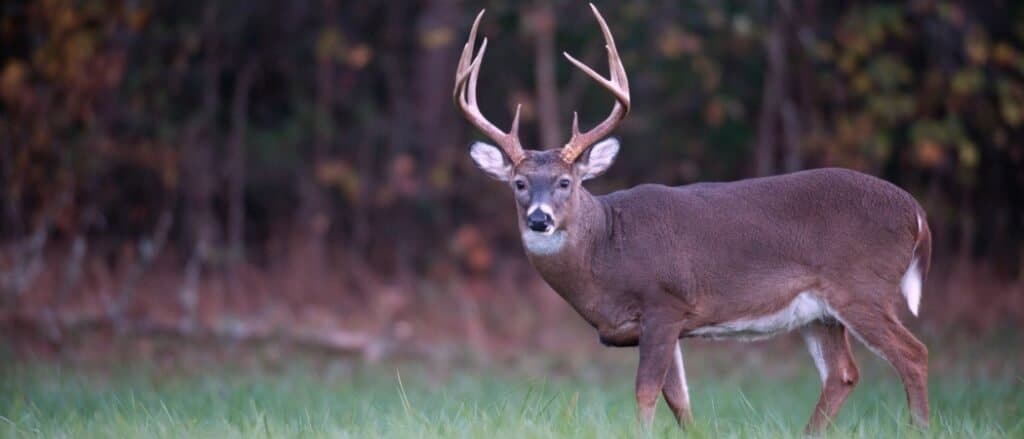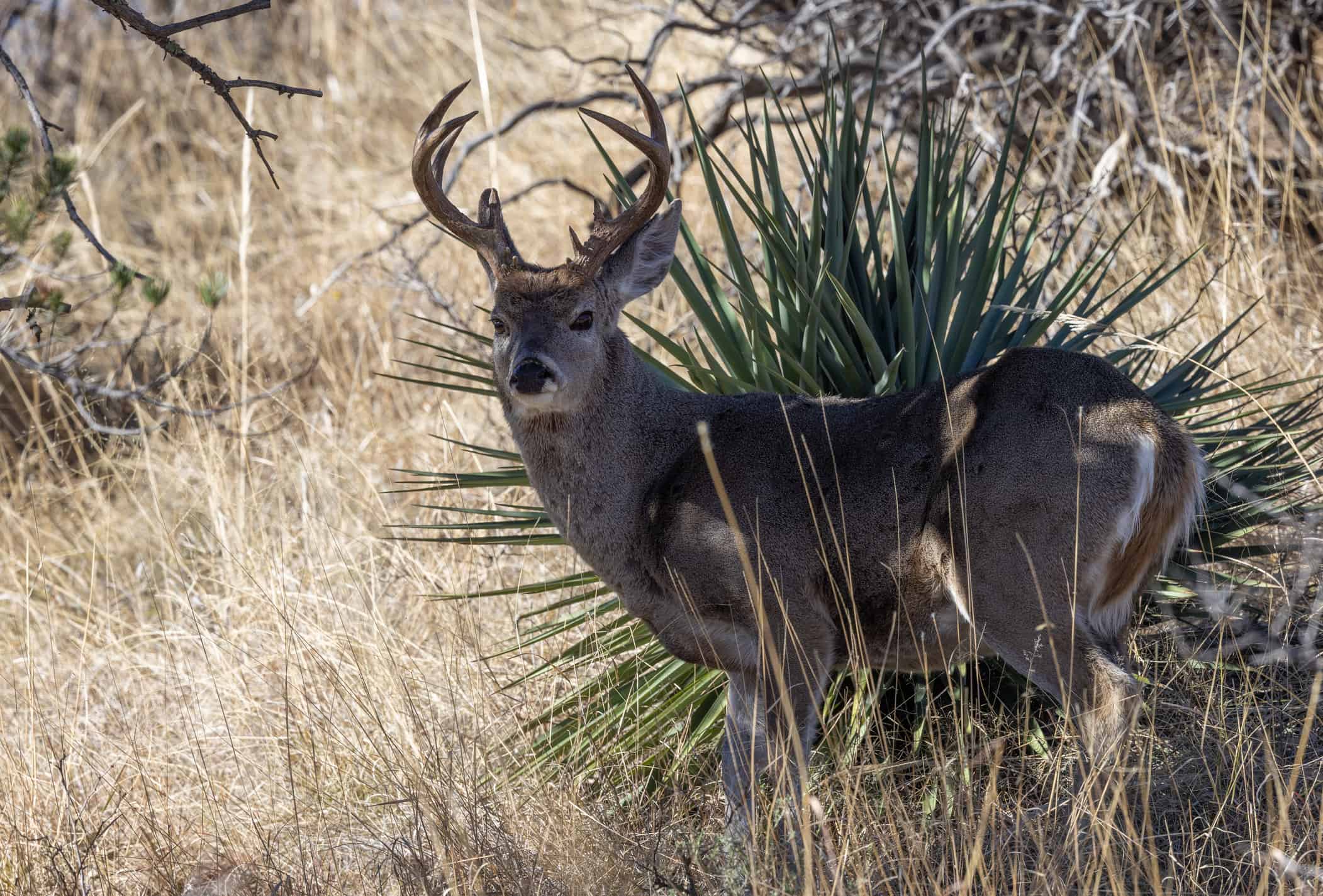While there are numerous species of deer that take up residence in the vast state of Texas, the whitetail deer is one of the most distinct. Its strong stature, graceful gait, and iconic white tail make it instantly recognizable. And although it is not the biggest species of deer in Texas, the state’s largest whitetail deer still sets an impressive record.
In this article, we’ll take a look at the records for the largest deer ever hunted in the state. Afterward, we’ll look at whitetail deer in general and learn about where they live, what they eat, and how their appearances change with the seasons.
Largest Whitetail Deer In Texas

One way deer are scored is by the Boone and Crockett system, which takes into account four different
antler
measurements and the symmetry of the antlers.
©Tom Reichner/Shutterstock.com
Texas has a pretty impressive record for its largest whitetail deer. Once taken, each deer is measured and given a score by way of a specific measuring process. Rather than by weight, bucks receive a score based on various measurements of their antlers.
Let’s take a look at how the scoring process works. Then, we’ll look at a few of the state’s highest-scoring bucks and their associated records.
How Are Whitetail Deer Scored?
Because deer are all unique individuals, the sizes and shapes of their antlers can vary dramatically. A “typical” deer has pretty much symmetrical antlers, meaning that the number and placement of points are even on both sides. Each point tends to be smooth and tapers to, well, a point.
Non-typical deer can be quite different. While they may have regularly-shaped points, these might be distributed very asymmetrically between each antler. Points can turn upwards, downwards, inwards, or grow in strange clusters. They might be oddly conical, have blunt tips, or be exceptionally thick. Though the distinction is sometimes arbitrary, you’d know a really non-typical deer if you saw one.
There are a few different scoring systems through which hunters can determine whether they’ve caught the largest whitetail deer. The scores we have on hand below use the Boone and Crockett system of scoring, which takes into account four different antler measurements as well as their symmetry. The scoring hunter takes length measurements of each antler’s main beam, then the points themselves, and then the thicknesses at varying points. They also measure the widest distance between the two antlers. The resulting total of all of these measurements accounts for the buck’s gross score.
Once the gross score is in hand, deductions can be made for asymmetry and abnormal points depending on whether the hunter is scoring the deer as typical or non-typical.
Largest Typical
The highest-scoring typical whitetail deer on record in the state of Texas was, for many years, the McCulloch deer. This deer hunted in 1963, held the record for typical deer for nearly 60 years. Alberto Bailleres finally broke the record in 2021 with a buck scoring over 197 inches of antler growth.
Largest Non-Typical
While the Texas record for typicals finally gave way in recent years, the non-typical record is quite the opposite. A buck caught in 1892 by an unnamed hunter still holds the state record to this day — by a decent margin, too. This buck held an impressive 284 inches of total antler growth. That’s up there with some of the highest-scoring bucks ever recorded on the continent!
Facts About Whitetail Deer

Whitetail deer are widespread throughout the United States, with over 5 million in Texas alone.
©EEI_Tony/Shutterstock.com
Now that we’ve looked at the largest whitetail deer in Texas, let’s learn a bit about whitetail deer in general. There are over 5 million of them in the state of Texas alone, and they make their homes in nearly every single one of the state’s counties. In fact, Texas has the largest population of whitetail deer in the country.
Whitetail deer are fast and agile creatures, and while they are very strong, they are also graceful. They are able to live in a range of environments and adapt well to each one. Let’s take a look at some of the basic characteristics of whitetail deer, as well as how they behave.
Appearance
For part of the year, whitetail deer have short-haired, reddish-brown coats. In the winter, to better blend into their surroundings, their coats take on a greyer hue. But the color is not all that changes. While the deer’s summer coat is thin and single-layered, which helps manage the summer heat. With the change of the seasons, the deer begins to molt, developing two distinct fur layers. The first, inner coat is a soft insulation layer that protects against the cold. The outer coat is quite a bit longer and made up of stuff, hollow guard hairs.
Seasonal changes occur in more than just the fur. During the spring, male deer, called bucks, begin to grow their antlers. While they are new, they have a protective, velvety covering. This velvet disappears by late summer, giving way to hardened antlers. While they may use their new antlers in self-defense, the deer use them primarily in mating ritual and competition.
Although individuals of the species change in appearance over the course of the year, one important trait pervades every season: the white underside of the tail. These deer use their characteristic tails as part of their body language — not only to signal danger but also for general communication.
Diet
Whitetail deer can get pretty big, with adult males reaching average weights between 200 and 300 pounds. They can sometimes get much larger, though. In 1977, a Canadian hunter took the largest buck on record, which weighed over 500 pounds! While female deer tend to stay smaller, their average weights of 100–200 pounds are still pretty hefty. But what do whitetails eat that allows them to reach and maintain such high weights? Let’s look at some of the foods they eat season-to-season.
These deer are herbivorous and eat a wide variety of plants and fungi to keep themselves going. They aren’t picky eaters, either — they’ll eat poison ivy just as quickly as they will your flower garden. But as the seasons change, so does the availability of different kinds of foods.
In the spring, they feed mostly on the tender new growth of various trees, shrubs, and grasses. Clover is a popular choice as well. While newly-born whitetails drink their mother’s milk for the first couple of months of their lives, they begin to forage very quickly.
During the summer, when most vegetative growth peaks, they tend to eat the various flowers and berries that begin to fill the landscape. Fruits like raspberries, cherries, and wild grapes all make the menu, as well as flowers like honeysuckle.
Late in the summer and fall, whitetails continue to eat whatever is available but will especially take advantage of the abundance of seeds and nuts that begin to drop from the trees. In areas that experience harsh winters, these nutrient-dense foods are crucial in their preparation for the cold weather.
Where winters are cold and plants have mostly gone dormant, these deer will focus on woody browse. Twigs and buds are a large part of what they subsist on until the return of spring. Grasses, nuts, young saplings, and evergreen leaves are also important staples. If winters are snowy, they will push the snow away to find the food hidden beneath. They will also dig up nutrient-dense bulbs and corms.
Distribution And Habitat
The whitetail deer is a very populous species, and not just in Texas. Because they are so adaptable to different environments, these deer have a range that reaches nearly every U.S. state, as well as into Canada and Central America. They can weather harsh winters and hot summers and live everywhere from open fields to shady forests.
Just as these deer can adapt to a wide variety of environments, those environments shape the size and appearance of the deer that live in them. The further they live from the equator — that is, the colder an area gets — the larger they tend to be. Those deer that live in woodland environments also tend to have darker coats than those that spend more time out in the open.\
Where Is Texas Located On A Map?
Texas is located in the south-central part of the United States. It shares a bored with the Gulf of Mexico to the southeast, Louisiana to the east, Oklahoma to the north, Arkansas to the northeast, New Mexico to the west, and the following states of Mexico to the south: Chihuahua, Ciudad Juarez, Coahuila, Nuevo Leon, and Tamaulipas.
Thank you for reading! Have some feedback for us? Contact the AZ Animals editorial team.








